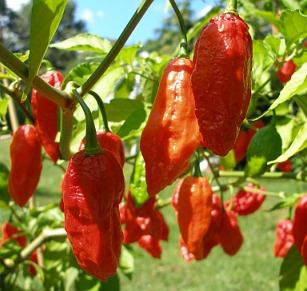|
The Bhut Jolokia Pepper
Photo credit: essex899 at Flickr The Bhut Jolokia pepper goes by several names depending on what part of the world you're in and what language is spoken. Some of them include Naga Jolokia, Bhot Jolokia, Dorset Naga, or Naga Morich. This pepper originates in India and a lot of its names come from local history and languages. For example, one of the Indian states where this pepper is found is Nagaland. In the Assamese language jolokia means Capsicum pepper. Bhut translates to ghost. The pepper has been shown by DNA tests to be an interspecies hybrid, mostly C. chinense with some C. frutescens genes. World's Hottest Pepper Regardless of where it comes from or what you call it, this pepper is recognized as the world's hottest pepper. In February 2007, Guinness World Records certified the bhut jolokia as the world's hottest chile pepper. It displaced the Red Savina habanero which was previously recognized for this honor. Scoville Rating In 2000, scientists at India's Defence Research Laboratory (DRL) reported a rating of 855,000 units on the Scoville scale, and in 2004 an Indian company obtained a rating of 1,041,427 units through HPLC analysis. This makes the "ghost pepper" about twice as hot as the Red Savina pepper. As a comparison, Tabasco sauce has a Scoville rating of 2,500-5,000, and pure capsaicin rates at 15,000,000–16,000,000 Scoville units. In 2005, at New Mexico State University Chile Pepper Institute near Las Cruces, New Mexico, regents Professor Paul Bosland found naga jolokia grown from seed in southern New Mexico to have a Scoville rating of 1,001,304 SHU by HPLC. The scoville rating of this and other peppers depends on several factors such as where the pepper is grown and in what growing conditions.
|